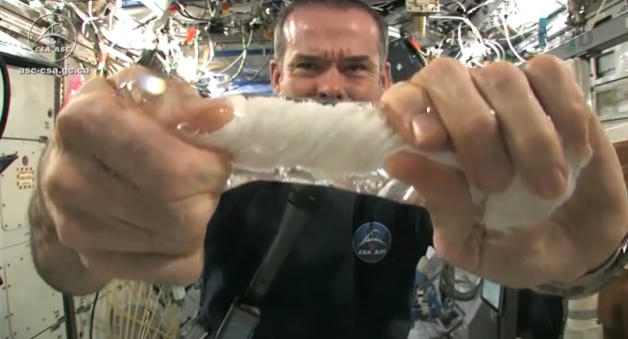The Week In Science: Space Washcloth Troubles, Sea Lions In Peril, New Madagascar Dinosaur

This week, we covered a number of exciting scientific finds: a way to freeze pain signals right at the nerves; the existential dread-curing properties of Tylenol; and two newly discovered planets that are the most attractive candidates yet for harboring life outside our solar system.
But we can’t always get to everything! So here's a roundup of other findings and discoveries, and oddities from the past week:
Canadian astronaut Chris Hadfield demonstrated how impossible it is to wring out a washcloth in space:
Scientists peering deep into space have found a starburst galaxy that’s a lot older, farther and more active than expected – churning out enough matter each year equal to about 2,900 times the weight of our sun. [National Geographic]
A new species of dinosaur was discovered in Madagascar. Dahalokely tokana (a name that means “lonely small bandit” in Malagasy) was a carnivore between nine and 14 feet long, and fills an important gap in the Madagascar fossil record – until now, no dinosaur remains had been found on the island from between 165 and 70 million years ago. [ScienceDaily press release]
More and more sea lions are beaching themselves on Southern California shores. On Wednesday, scientists hypothesized that something is preventing the sea lion pups from feeding, possibly an oceanographic phenomenon like El Nino, or a toxic algae bloom. [LiveScience]
The monster waves generated by Hurricane Sandy last year caused seismic waves traveling through the U.S. that could be detected as far away as Seattle. [Smithsonian Magazine]
How do you get rid of trash in orbit? With a giant space harpoon, of course. [CNN]
The grasses in the Chesapeake Bay are at their lowest coverage in 36 years. These underwater plants provide food and shelter to many bay inhabitants, including fish, crabs, birds and turtles. [Baltimore Sun]
A new way to detect colorectal cancer without a colonoscopy performed well in a trial. The test, which looks for DNA alterations in a human stool sample, found 92 percent of the cancers and 42 percent of the potentially troublesome polyps the more invasive procedure found – still not quite as good as the results investors were expecting, however. [New York Times]
Did dinosaurs sit on their eggs like birds, or bury them like crocodiles? New evidence suggests it’s the former – when scientists closely examined the fossilized eggs of a Late Cretaceous denizen, the troodon, they saw that the eggshells were similar to those of the Egyptian plover, which partially buries its eggs in the sand, but sits atop them as well. [LiveScience]
Much of the charcoal from wildfires is carried out to the ocean, instead of remaining in the soil as it was previously assumed to do. [Max Planck Institute press release]
Russia sent a rocket into space with numerous small animals aboard an attached capsule, including 45 mice and 15 newts. Scientists will be studying the effects of weightlessness on the animals after they spend 30 days in orbit, paving the way for future manned missions to Mars. [AFP]
Geophysicists stumbled across a strange circular structure under the Sea of Galilee in Israel. [CNN]
© Copyright IBTimes 2024. All rights reserved.





















